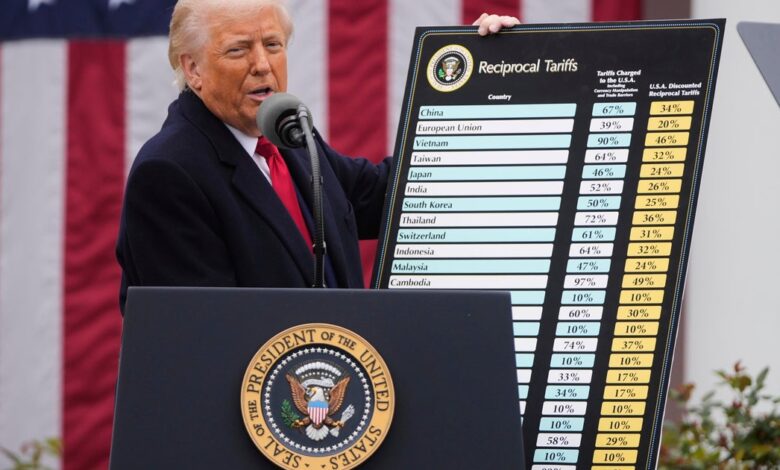See the full list of reciprocal tariffs by country from Trump’s “Liberation Day” chart

A global trade war is escalating as the United States imposes tariffs on a growing number of countries, sparking concerns about economic growth and causing turbulence in stock markets worldwide.
On April 2, President Trump announced reciprocal tariffs on imports from approximately 90 nations, with a minimum 10% tax applied to all imports into the U.S. This move, dubbed “Liberation Day” by the president, aims to address the trade deficit between the U.S. and other countries, including China and the European Union.
While some countries are facing the universal 10% tariff, others are subject to higher specific reciprocal import duties. For example, Australian imports are hit with a 10% rate, while Chinese products now face a staggering 104% duty, combining reciprocal tariffs with previously imposed charges. In his remarks on April 2, Trump emphasized the principle of reciprocity in trade relations.
However, in a surprising turn of events on April 9, Trump announced a 90-day pause on the reciprocal tariffs, reducing the rate to 10% for most nations except China, which saw its tariff rate increase to 125%. This decision led to a significant surge in stock prices, with the S&P 500 rising by 8.4% and the Dow Jones Industrial Average climbing by 7%. Despite the positive market reaction, some experts warn of potential volatility when the pause ends in 90 days.
Before the pause announcement, Asian countries were expected to bear the brunt of the tariffs, with Cambodia facing a 49% tax rate and Vietnam at 46%. Trump justified these levies as a means to boost domestic manufacturing and create a level playing field with countries that impose higher tariffs on U.S. imports.
Economists predict that the tariffs may reignite inflation and trigger retaliatory measures from trade partners, potentially leading to recessions in both the U.S. and other nations. China, for instance, retaliated by imposing a 34% import fee on American products, prompting Trump to announce an additional 50% tariff, which China escalated to 84%.
The European Union also responded by imposing tariffs on over $22 billion worth of U.S. products, citing the unjustified and damaging nature of U.S. tariffs. These trade tensions have raised concerns about the global economy and the possibility of a prolonged trade war between major economies.
In conclusion, the impact of these reciprocal tariffs on global trade remains uncertain, with potential consequences for economic growth and market stability. The evolving trade landscape underscores the importance of diplomatic negotiations and collaborative solutions to address trade imbalances and foster international cooperation.





